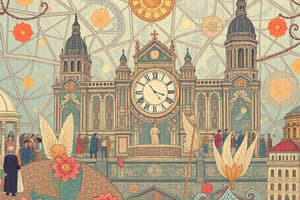Podcast
Questions and Answers
What does culture provide group members in an organization?
What does culture provide group members in an organization?
- An escape from daily routines
- Unpredictability in decision-making
- Limitless creativity and innovation
- Clear guidelines for behavior (correct)
According to Jaques, what must new members learn to be accepted into a firm?
According to Jaques, what must new members learn to be accepted into a firm?
- External norms and values
- Creative innovation approaches
- The traditional way of thinking and doing things (correct)
- Advanced problem-solving techniques
How does culture affect anxiety in an organization?
How does culture affect anxiety in an organization?
- It reduces and contains anxiety (correct)
- It allows for unpredictable events
- It has no impact on anxiety levels
- It increases anxiety by creating uncertainty
What concept refers to the shared customs and practices of an organization?
What concept refers to the shared customs and practices of an organization?
What did Edgar Schein believe culture to be?
What did Edgar Schein believe culture to be?
Which of the following is NOT a characteristic of culture in organizations?
Which of the following is NOT a characteristic of culture in organizations?
What is a professional culture characterized by?
What is a professional culture characterized by?
How can culture be conveyed to new members of an organization?
How can culture be conveyed to new members of an organization?
What should be the primary focus when addressing cultural change within an organization?
What should be the primary focus when addressing cultural change within an organization?
Which aspect of cultural change requires addressing both reasoning and emotional responses?
Which aspect of cultural change requires addressing both reasoning and emotional responses?
Why is it essential to pilot change within an organization?
Why is it essential to pilot change within an organization?
What must management ensure when implementing cultural change?
What must management ensure when implementing cultural change?
How should the process of cultural change be viewed according to the content?
How should the process of cultural change be viewed according to the content?
What term describes the visible elements of culture in an organization?
What term describes the visible elements of culture in an organization?
Which characteristic indicates that culture is a learned phenomenon?
Which characteristic indicates that culture is a learned phenomenon?
Which of the following represents the deeper, unobservable level of culture?
Which of the following represents the deeper, unobservable level of culture?
What aspect of culture reflects behaviors and practices commonly observed within an organization?
What aspect of culture reflects behaviors and practices commonly observed within an organization?
Which statement best describes how culture evolves over time?
Which statement best describes how culture evolves over time?
What method is primarily used to transmit culture to new members in an organization?
What method is primarily used to transmit culture to new members in an organization?
Which of the following elements is NOT considered a surface-level element of culture?
Which of the following elements is NOT considered a surface-level element of culture?
What is a defining feature of artefacts in organizational culture?
What is a defining feature of artefacts in organizational culture?
What does the process of sensemaking prioritize in its quest for understanding?
What does the process of sensemaking prioritize in its quest for understanding?
Which of the following is NOT one of the seven characteristics of sensemaking identified by Weick?
Which of the following is NOT one of the seven characteristics of sensemaking identified by Weick?
How does social interaction contribute to the sensemaking process?
How does social interaction contribute to the sensemaking process?
What role does identity play in sensemaking?
What role does identity play in sensemaking?
What does sensemaking involve according to Weick?
What does sensemaking involve according to Weick?
Which of the following best captures the nature of sensemaking as described?
Which of the following best captures the nature of sensemaking as described?
Which statement aligns with the idea of collective sensemaking?
Which statement aligns with the idea of collective sensemaking?
In sensemaking, the retrospective aspect refers to which of the following?
In sensemaking, the retrospective aspect refers to which of the following?
What is necessary for effective cultural change within an organization?
What is necessary for effective cultural change within an organization?
Which of the following is a trap that can occur during cultural change management?
Which of the following is a trap that can occur during cultural change management?
What is a key characteristic of transitional change?
What is a key characteristic of transitional change?
What should be avoided when forwarding content during cultural change?
What should be avoided when forwarding content during cultural change?
What does it mean to have a change in the organization’s operating reward system?
What does it mean to have a change in the organization’s operating reward system?
Which of the following describes a misconception related to understanding values during cultural change?
Which of the following describes a misconception related to understanding values during cultural change?
What should leaders do to clarify identities and role expectations during cultural change?
What should leaders do to clarify identities and role expectations during cultural change?
What is a suggested practical lesson for managing cultural change?
What is a suggested practical lesson for managing cultural change?
Flashcards are hidden until you start studying
Study Notes
Culture in Organizations
- Culture in organizations derives from anthropology and sociology; it guides members' behavior and meaning-making.
- Defined as shared customs and traditional ways of thinking and acting within a group, vital for organizational acceptance.
- Culture provides meaning, sets behavioral guidelines, and alleviates anxiety in unpredictable environments.
Learning Culture
- Culture is learned through formal (training) and informal (socialization) processes.
- Organizations may possess an overarching corporate culture supplemented by various sub-cultures and professional cultures.
Edgar Schein's Perspective
- Schein defines culture as a pattern of basic assumptions developed to cope with external challenges and internal dynamics.
- Culture consists of three levels:
- Artefacts: Observable structures and behavior.
- Espoused Beliefs and Values: Ideals, goals, and aspirations.
- Basic Underlying Assumptions: Unconscious beliefs that shape perception and behavior.
Characteristics of Culture
- Culture is shared among members and exists at multiple levels—visible and hidden.
- It evolves in response to common experiences while remaining generally stable over time.
Surface vs. Deeper Level Elements
- Surface elements (physical layout, organizational structure, dress codes) are observable and reflect culture.
- Deeper elements (beliefs, assumptions) are unobservable, developed from shared experiences and often taken for granted.
Power of Culture in Change Management
- Socialization is crucial for transmitting culture to new members; practical changes (e.g., symbols, training) are necessary to foster commitment.
- Acknowledging local cultures avoids oversimplification during corporate change initiatives.
Management Traps in Cultural Change
- Common traps include oversimplification of culture, neglecting local symbols, assuming shared meanings, and denial of differing perceptions post-change.
Practical Lessons for Managing Cultural Change
- Engage all levels in the change process to build a shared understanding; meaningful change requires time and attention.
- Focus on local context, clear communication regarding change, and adapt tactics based on employee interpretations.
Sensemaking in Organizational Change
- Sensemaking involves individuals interpreting events and shaping their understanding; it is a continuous process influenced by social interactions.
- Retrospection and prospective reflections play critical roles in how individuals make sense of their experiences.
Characteristics of Sensemaking
- Grounded in identity, sensemaking is retrospective, social, and ongoing, focusing on plausible interpretations rather than accuracy.
Collective Sensemaking
- Collective sensemaking emerges through storytelling, where individuals create and redefine their experiences through interaction.
Studying That Suits You
Use AI to generate personalized quizzes and flashcards to suit your learning preferences.




